The city of Narva is located in northeast Estonia, on the border with Russia. It is an important city -third of Estonia- and can be considered as the center of the Russian minority.
Narva is located on river with the same name and the river is now the border with Russia.
On the other side lies the Russian Ivangorad. On the map in Baedeker -1912 – (see below) we see at this place on the right bank the district ‘Iwangorodskij Vorstadt.’
On both sides there is a fort. The fort on the side of Narva in present form was built by the Swedes, called Herman Castle (Hermanni linnus).
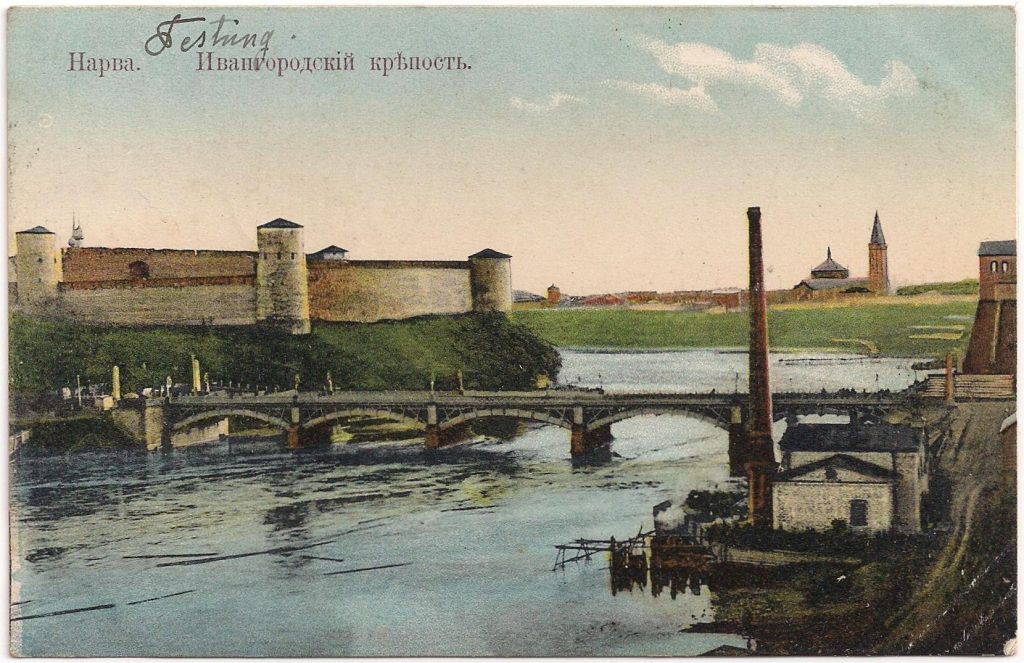
During the first Estonian Republic (1918-1940) Ivangorad with this fort was part of the Estonian Narva.
This card is sent from МЕРЕКЮЛЪ ЭСТЛ. (MEREKYUL EHST.). This place was therefore in the Government of Estonia. The current Estonian name Meriküla. Meriküla is located in northeastern Estonia, near Narva. The German name is Merrekühl.


The post office of МЕРЕКЮЛЪ ЭСТЛ. [MEREKYUL EHSTL.] / Meriküla is opened in 1897 as private or temporary Subpost Office or Postal Agency. This office closed February 24, 1900 and is opened February 25, 1900 as Post and Telegraph Branch Office.
In the EESTI handbook are mentioned more postmarks:
- in use from 1884-..: single circle with numbers at sides, Gubernia below, indication П.C. (coach station), (type 5B3), code number 1
- Gubernia at top, type of post office below П.Т.О., date in three lines (month in letters) (type 6A2): code number 1 and 2
- double circle date stamps, gubernia given, two stars and codeletter (type 7A1): 4 different code-letters
The fortresses
The history of the forts on both sides, also indicates the turbulent history of this area. Narva was the beginning of the 13th century an important border river, between Livonia and the Republic of Novgorod. The castle of Narva was founded in the second half of the 13th century, under the Danish rule of northern Estonia. Narva received city rights in 1345. In 1346 the castle and the town of Narva was by the Danish king sold to the Livonian Order.
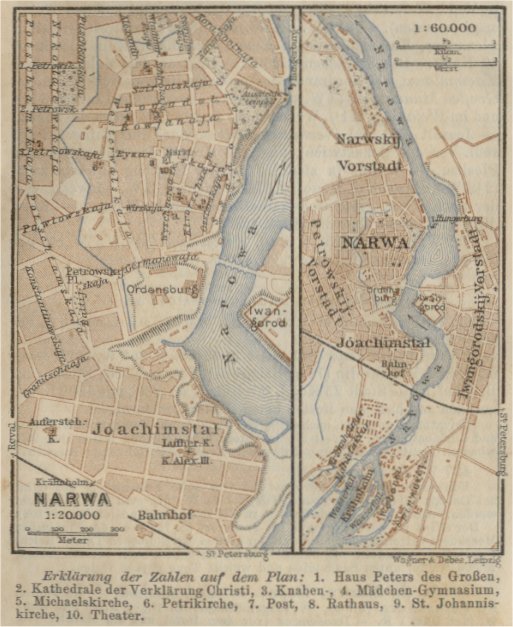
in 1256 by the Danes and from August 29, 1346 it was the castle of the German Livonian Teutonic Knights Order.
The castle on the other side, Ivangorod Castle is build by the Russians in 1492.
Map from: Baedeker 1912, p. 78.
Russland nebst Teheran, Port Arthur, Peking : Handbuch für Reisende / von Karl Baedeker. – 1912.
The fortress of Ivangorod was built in 1492 and -after completion- named after Ivan III Vasilevitsj. He was a prince of the Grand Principality of Muscovy between 1462 and 1505 and was nicknamed ’the Great’. He captured Novgorod, introduced the two-headed eagle as a symbol of the empire, and broke the ties with the Golden Horde, the Tatars. In 1558 – with the Livonian War, Narva became Russian, but in 1581 Narva was again Swedish. The Russians have made an attempt to recapture the city during the Swedish-Russian War (1590-1595), but that was unsuccessful. The defense of the city was greatly expanded during the Swedish period and became the strongest in Northern-Europe. Between 1581-1590 and 1612-1704 Ivangorod was also Swedish area. In 1704 -during the Great Northern War, Narva became again Russian under Tsar Peter the Great. The bastions were renovated and Narva remained a Russian fortress until 1863.

The card is send to Riga and has a KRAG-arrival postmark (-2.1.1915 ??)
There is no postage stamp on the card, but an fieldpost cancel.
In the postmark you can read in the circle: ТЗЪ [IZ], From, ДЕЙСТВУЮШИ.. [DEISTVUYUSHI..], Aktive, АРМИИ [ARMII], Army.
In the middle of the postmark is placed the text: ПЕЧАТЬ [PECHAT], seal/cachet, ДЛЯ [DLYA], for, ПАКЕТОВЪ [PAKETOV], Parcel/letter.
In World War I the garrison of Narva consisted of the 92nd 97th Infantry Regiments, but the card can be sent from elsewhere.
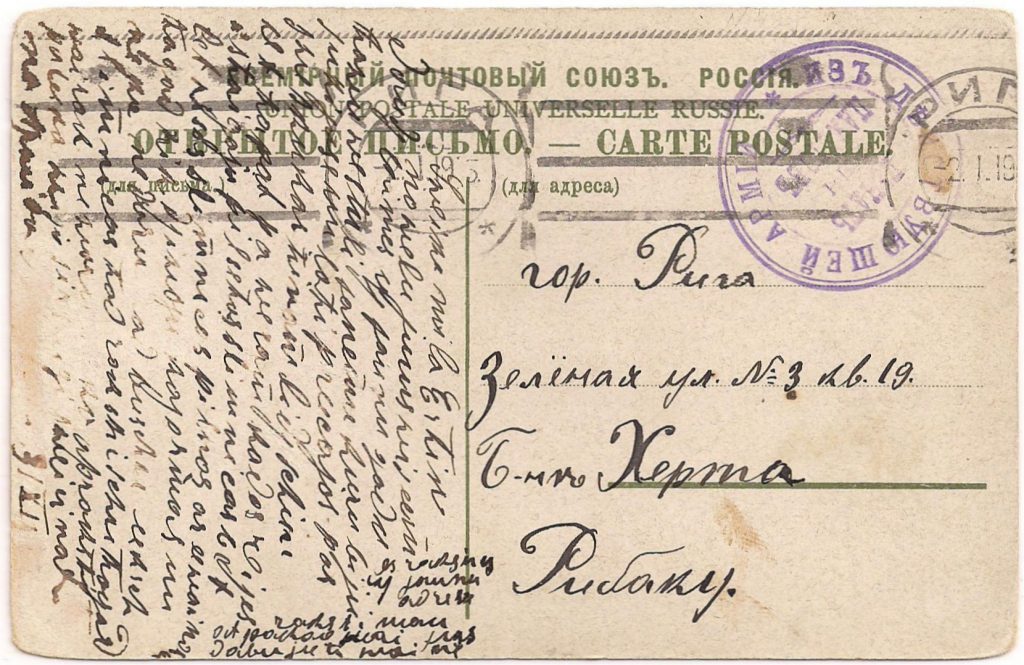
Postmarks

In the EESTI-handbook are listed 18 different pre-philatelic postmarks. Narva has also used a dotted postmark: rectangle, it was a District Post Office, with number 6.
There are used many circular date-stamps in Narva: 24 (10 single circle and 14 double circle postmarks).
The first 2 circular data-stamps are type fleuron: the first with only name НАРВА [NARVA] at the top and the date in three lines (type 3A1), the second also code number 1 (type 3A3).
Then follows type 4A2: posthorn type with name and code number 1.
After these is used a postmark with the indication of the gubernia below: type 5B1, date in three lines, single circle with code number 2 at sides, above the indication НАРВА [NARVA] ПОЧТ [POCHT.]. КОНТОРА [KONTORA].
In the indication below of the postmark the Gubernia is indicated as С. П. Б. ГУБ. [S. P. B. GUB.], St. Petersburg Gubernia.
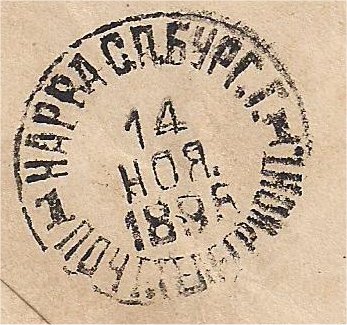
The post office of Narva has used two postmarks of this type: date in three lines, Gubernia at the top, type of post office below. This arrival postmark (on a cover from Revel) has below the indication ПОЧТ [POCHT.]. ТЕЛЕГР[TELEGR.]. КОНТ [KONT].
At the top is indicated the Gubernia as С. П. БУРГ. Г. [S. P. BURG. G.], St. Petersburg Gubernia.
The letter is arrived 14 НОЯ [NOYA] = Novermber, 1895.
This is subtype 6A1, with code number 1, used between 1887 and 1899.
There is another postmark of this type with code number 2.
The later ‘crossed-date’ type postmark, month in numerals, with Gubernia at top and indication ПОЧТ [POCHT.]. ТЕЛ[TEL.]. КОНТ [KONT]. for the post office below (type 6C1) has as code numbers: 1, 2, 3, and 4.
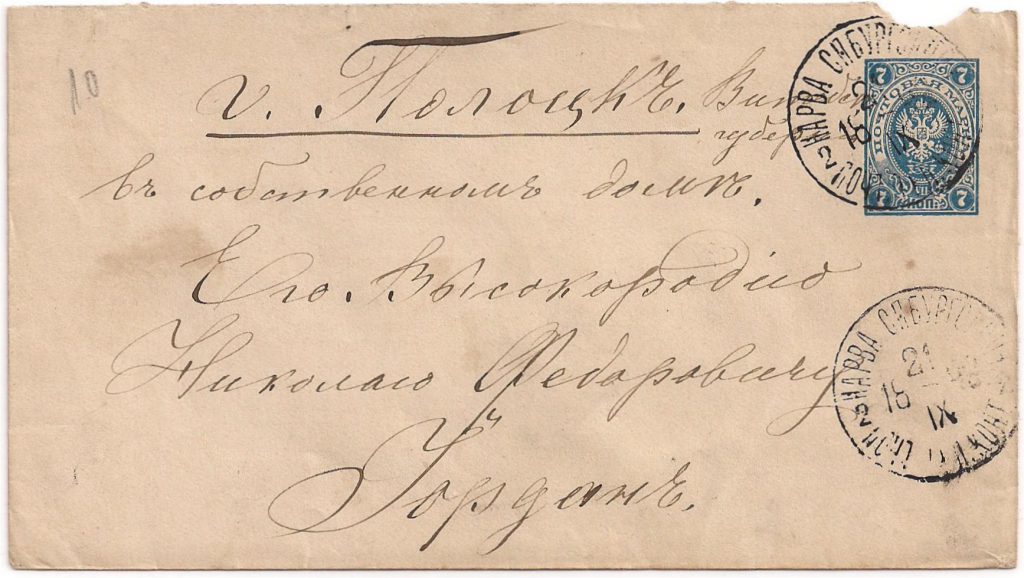
Between 1901 and 1918 in Narva are used two types of double circle postmarks:
*double circle, with gubernia indication, two stars and code letter * * a etc. (type 7A1), 9 different
* double circle, without gubernia indication, two stars and code letter * * a etc. (type 7B1), 5 different
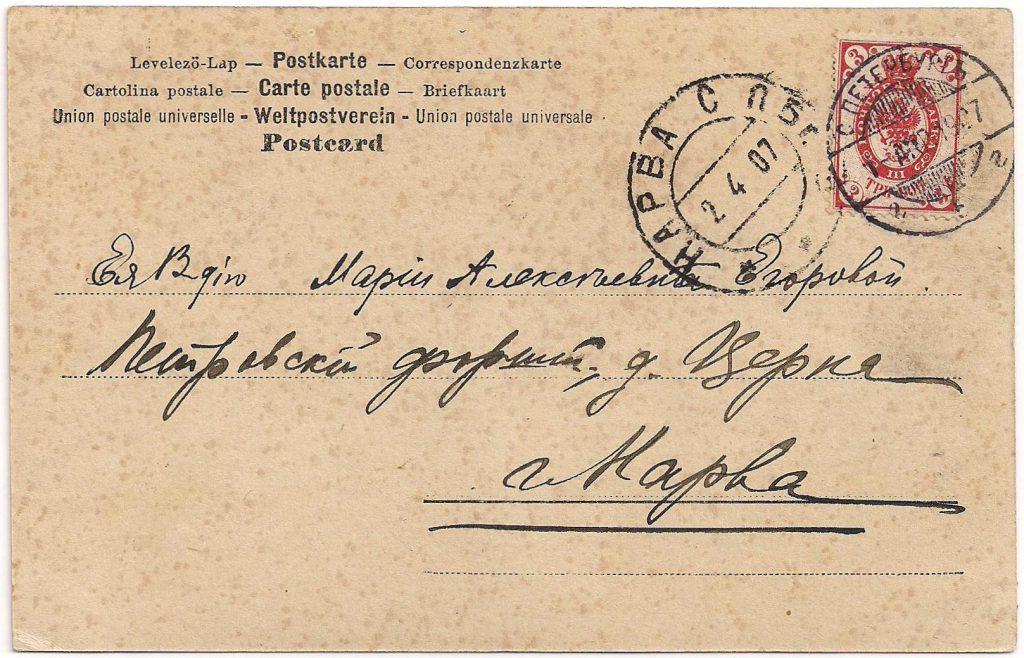

On the card below the other type double circle postmark of Narva is used: circle, without gubernia indication, two stars and code letter * * и [I], the writing letter i (type 7B1)
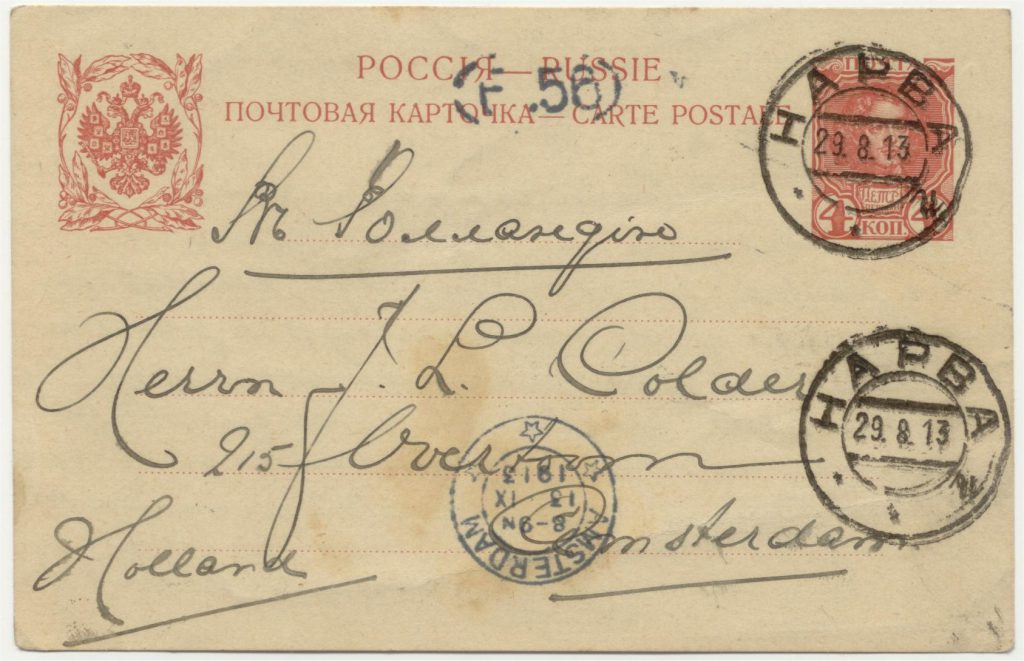

On the other side the message has as date: August 29 and September 11, 1913. We can see the two calendars indicated: our Gregorian and the -in Russia used- old Julian calendar. The Julian calendar was in Russia until February 1918 in use. To get the date of our Gregorian calendar, there must be 12 days to the Julian date added to dates after 28 February 1800 to 28 February 1900. After February 28, 1900 must have 13 days to the Julian date counted to get the Gregorian date.
All about calendars: www.norbyhus.dk/calendar.php
On this card: 1913, so we must have 13 days at the Julian date counted to get the Gregorian date.
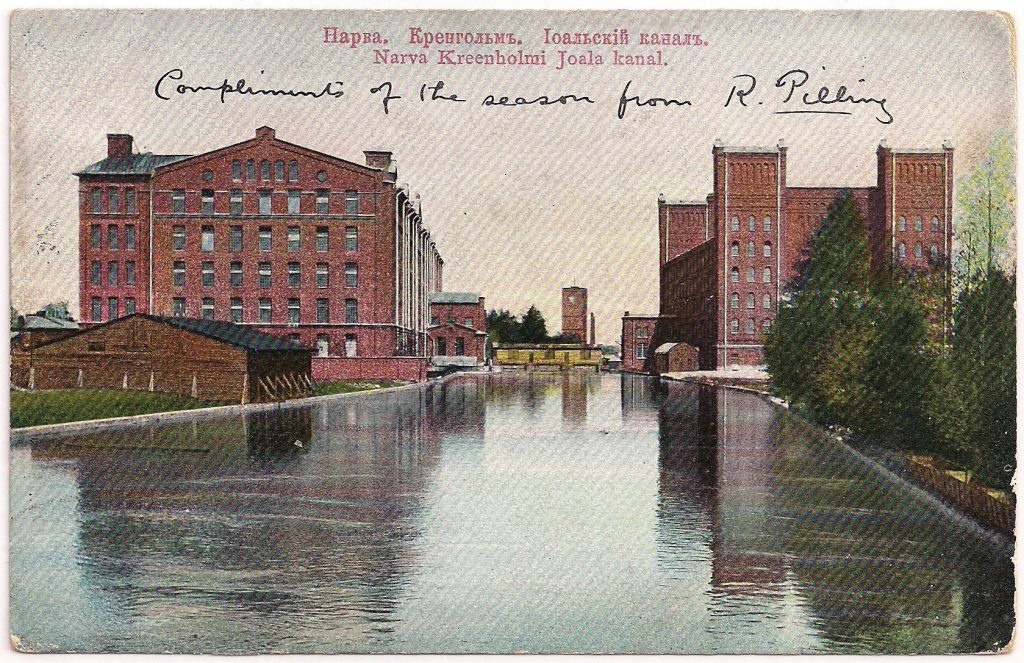
Baedeker (1914): “…… the Naróva forms two broad Waterfalls, 26-33 ft. high, the waters of which unite again below the island of Krähnholm. The river rushing over layers of hard limestone here falls upon soft clay, the gradual washing-away of which has formed the falls. Below the falls the channel of the river is deep and enclosed by precipitous banks, but above the falls the banks are more level. The beauty of the falls is much impaired by the mills erected to utilize the water-power. On the left bank, on this side of the bridge leading to the island, is a bronze statue of Baron Knoop, the founder of the Krähnholm Mills, by Tchizhóv (1899). The bridge commands a good view, to the right, of the W. fall. The view of the E. fall is finer, but special permission from the management of the mills is required for the island.” ….”The train now crosses the Naróva by an iron bridge (good view of Narva and Ivangorod to the left and of the waterfalls to the right) and enters the Government of St. Petersburg.”
From: Russia / Baedeker 1914. – p. 83
In 1856 Baron Knoop, Ludwig Knoop, was owner of the island and he founded there a textile factory: Krenholm Manufacturing Company. It became the most important factory in Russia and the cotton spinning and manufacturing mills were the largest in the world.
More about this : en.wikipedia.org/wiki/Krenholm_Manufacturing_Company.
Now the border between Estonia and Russia runs through the eastern branch of the waterfalls.
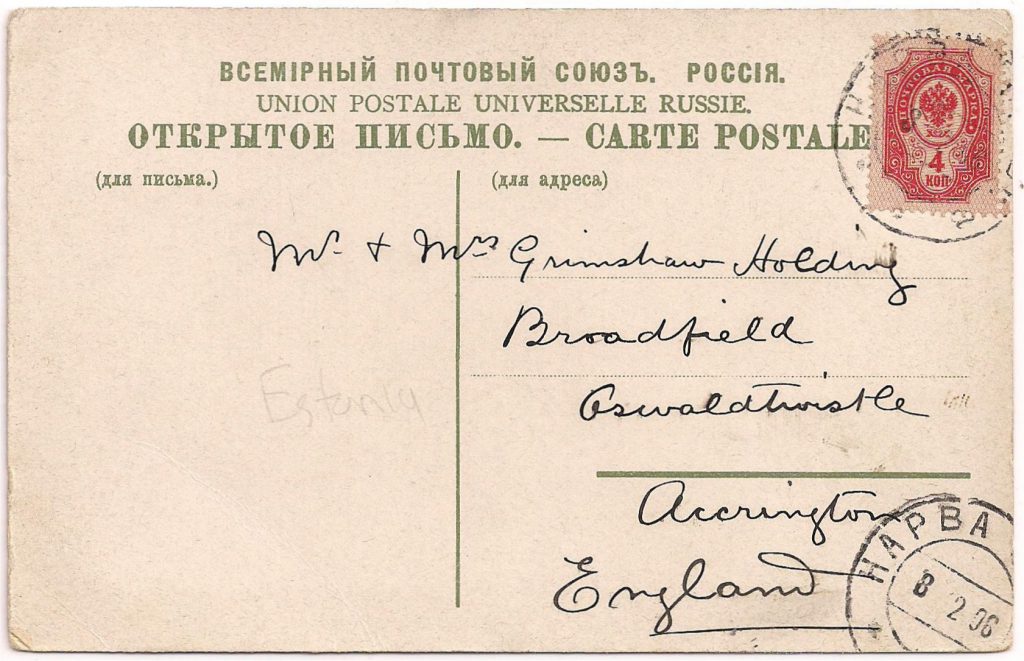
Article about (postal) history of Narva and Narva-Jõesuu [in Dutch]:
Narva en Narva-Jõesuu tot 1945 / Jan Kaptein. – In: Het Baltische Gebied 2011 ; 59. – p. 4-13